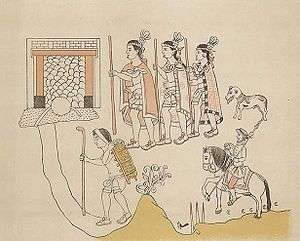Tlaxcaltec
The Tlaxcalans, or Talaxcaltecs, are an indigenous group of Nahua ethnicity who inhabited the republic of Tlaxcala and present-day Mexican state of Tlaxcala.
| Regions with significant populations | |
|---|---|
| Mexico (Tlaxcala) | |
| Languages | |
| Nahuatl, Spanish | |
| Religion | |
| Roman Catholicism | |
| Related ethnic groups | |
| Nahua, Otomi |
Pre-Columbian history
The Tlaxcaltecs were originally a conglomeration of three distinct ethnic groups who spoke Nahuatl, Otomi, and Pinome. Eventually, the Nahuatl speakers became the dominant ethnic group.[1]
Despite early attempts by the Mexica, the Tlaxcaltecs were never conquered by the Aztec Triple Alliance. The Aztecs allowed them to maintain their independence so that they could participate in the xochiyaoyatl (flower wars) with them to facilitate human sacrifice.[2]
Spanish colonial history

The Tlaxcaltecs served as allies to Hernán Cortés and his fellow Spanish conquistadors, and were instrumental in the invasion of Tenochtitlan, capital of the Aztec empire, helping the Spanish reach the Valley of Anahuac and providing a key contingent of the invasion force.[3]
Due to their alliance with the Spanish Crown in the conquest of Mexico, the Tlaxcaltecs enjoyed some privileges among the indigenous peoples of Mexico, including the right to carry guns, ride horses, hold noble title, and to rule their settlements autonomously.
The Tlaxcaltecs were also instrumental in the establishment of a number of settlements in Northern Mexico (including parts of present-day southeastern Texas), where conquest of local tribes by the Spaniards had proved unsuccessful.[4] They were taken to areas inhabited by nomadic bellicose tribes (known as the Chichimeca) to serve as examples for the local indigenous groups of sedentary model subjects of the Spanish Crown and to work in mines and haciendas.
The Tlaxcaltec colonies in the Chichimeca included settlements in the modern states of San Luis Potosí, Zacatecas, Durango, Coahuila, Nuevo León—Nueva Tlaxcala de Nuestra Señora de Guadalupe de Horcasistas, today known as Guadalupe, and Santiago de las Sabinas, today known as Sabinas Hidalgo—and Jalisco (Villa de Nueva Tlaxcala de Quiahuistlán, today known as Colotlán).
Post-colonial history
As of the 2000 Mexican census, there were more than 23,000 speakers of Nahuatl in Tlaxcala.[5]
Notes
- Charles Gibson, Tlaxcala in the Sixteenth Century
- Diego Muñoz, Historia de Tlaxcala
- Bernal Díaz del Castillo, The Discovery and Conquest of Mexico
- Manuel Orozco y Berra, Historia antigua y de la conquista de México
- Source: INEGI (2000)